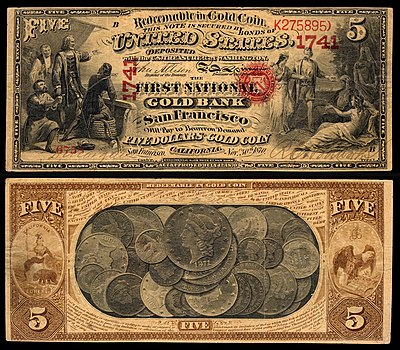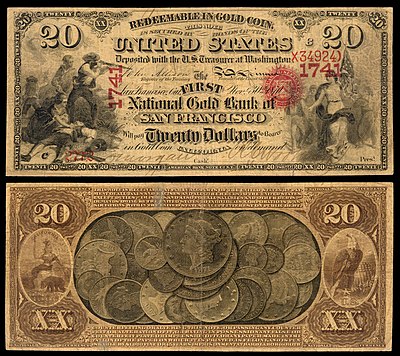| This is the talk page for discussing improvements to the National Gold Bank Note article. This is not a forum for general discussion of the article's subject. |
Article policies
|
| Find sources: Google (books · news · scholar · free images · WP refs) · FENS · JSTOR · TWL |
| This article is rated Start-class on Wikipedia's content assessment scale. It is of interest to the following WikiProjects: | ||||||||||||||||||||||||
| ||||||||||||||||||||||||
Past Discussion
This article is being linked to by other pages in progress and is being tested in the articles in progress.
- The deleted version had zero contents - except a {{stub}}. This are clearly speedy deletion candidates, and have been and will be deleted on sight. However now the article HAS contents, though not much yet and which needs to be wikified, but now it's no longer a speedy deletion candidate anymore. andy 11:10, 14 Jun 2005 (UTC)
- I'd like to reiterate what Andy has already said in that there is no need to delete this article now that it has content and anyone who does is breaking wikipedia guidelines. Just putting the {{stub}} message in and nothing else is grounds for speedy deletion but this is not the case here. In future if you are in the process of working on a page and would like others to leave it alone until you have finished, you can put the {{inuse}} tag into the main body of the article until you have finished, though this should normally only be used for an outside maximum of a few hours. -- Francs2000 | Talk [[]] 15:50, 14 Jun 2005 (UTC)
Merge
I would not recommend the merge as The Gold certificate article lacks any references. National Gold Bank notes were in response to the California Gold Rush. While the series Gold Certificates of 1882 were the first for regular circulation.Knowledgekid87 19:46, 29 January 2009 (UTC)
- The suggestion seems dead, but I would like to add that it would be a horrible idea to merge an article on NGBN with one on Gold Certs - they are very different types of notes. The former were part of the National Banking System and the latter were representative money like the Silver Certs.LondonYoung (talk) 20:13, 1 July 2009 (UTC)
- I remember I had agreed on that and just dropped the proposal it was bot added anyways. It was kind of like combining apples with oranges there. Knowledgekid87 19:54, 1 July 2009 (UTC)
$1,000 bill is not mentioned by Friedberg
I would be inclined to trust the Friedbergs here as they are the ones who came up with the Friedberg numbering system.[1], [2], [3] ("The world buys and sells paper money by Friedberg numbers") Can anyone provide more evidence that a #1,000 National Gold Bank was indeed printed but never released outside of the parroted origin source? Just to compare, the $500 note is mentioned as F-1166a despite there being no notes known. - Knowledgekid87 (talk) 00:07, 7 October 2019 (UTC)
- Knowledgekid87 According to the citation, the $1,000 NGBN is mentioned in the 19th edition of Friedberg. I don't own the book, but my guess is that the note lacks an Fr number because it was never circulated. The $500 note was circulated, and therefore has been assigned an Fr number, despite the lack of known survivors. - ZLEA T\C 14:27, 9 October 2019 (UTC)
Requested move 9 October 2019
- The following is a closed discussion of a requested move. Please do not modify it. Subsequent comments should be made in a new section on the talk page. Editors desiring to contest the closing decision should consider a move review after discussing it on the closer's talk page. No further edits should be made to this discussion.
The result of the move request was: Moved. (closed by non-admin page mover) Sceptre (talk) 19:49, 16 October 2019 (UTC)
National gold bank note → National Gold Bank Note – "National Gold Bank Note" is a proper name, which, according to WP:NCCAPS, should be capitalized. ZLEA T\C 14:38, 9 October 2019 (UTC)
- This is a contested technical request (permalink). Anthony Appleyard (talk) 14:53, 9 October 2019 (UTC)
- @ZLEA: queried move request Anthony Appleyard (talk) 14:54, 9 October 2019 (UTC)
- Move per nom, I don't see this as controversial. - Knowledgekid87 (talk) 02:03, 16 October 2019 (UTC)
- The above discussion is preserved as an archive of a requested move. Please do not modify it. Subsequent comments should be made in a new section on this talk page or in a move review. No further edits should be made to this section.
File:US-NBN-CA-San Francisco-1741-1870-5-6758-B.jpg scheduled for POTD
Hello! This is to let editors know that the featured picture File:US-NBN-CA-San Francisco-1741-1870-5-6758-B.jpg, which is used in this article, has been selected as the English Wikipedia's picture of the day (POTD) for July 17, 2020. A preview of the POTD is displayed below and can be edited at Template:POTD/2020-07-17. Any improvements or maintenance to this article should be made before its scheduled appearance on the Main Page. If you have any concerns, please place a message at Wikipedia talk:Picture of the day. Thank you! Cwmhiraeth (talk) 10:47, 4 July 2020 (UTC)

|
National Gold Bank Notes were issued by banks in California in the 1870s and 1880s, following the California Gold Rush. Gold coinage was the preferred means of exchange during this period but coinage was difficult for larger transactions, so these national bank notes were issued, redeemable in gold. Printed on yellow-tinted paper, the six denominations that circulated were $5, $10, $20, $50, $100, and $500. A $1,000 note was designed and printed, but never issued. Today, the higher-denomination notes are very rare, and only about 630 National Gold Bank Notes of all denominations are known still to be in existence. This picture shows a five-dollar National Gold Bank Note issued by the First National Gold Bank of San Francisco. The note is hand-signed by Edwin D. Morgan and Ralph C. Woolworth, the bank's cashier and president, respectively. Other denominations:Banknote design credit: Continental Bank Note Company; photographed by Andrew Shiva
Recently featured:
|

|
National Gold Bank Notes were issued by banks in California in the 1870s and 1880s, following the California Gold Rush. Gold coinage was the preferred means of exchange during this period but coinage was difficult for larger transactions, so these national bank notes were issued, redeemable in gold. Printed on yellow-tinted paper, the six denominations that circulated were $5, $10, $20, $50, $100, and $500. A $1,000 note was designed and printed, but never issued. Today, the higher-denomination notes are very rare, and only about 630 National Gold Bank Notes of all denominations are known still to be in existence. This picture shows a ten-dollar National Gold Bank Note issued by the First National Gold Bank of Oakland. The note is hand-signed by Galen M. Fisher and Benjamin F. Ferris, the bank's cashier and president, respectively. Other denominations:Banknote design credit: Continental Bank Note Company; photographed by Andrew Shiva
Recently featured:
|

|
National Gold Bank Notes were issued by banks in California in the 1870s and 1880s, following the California Gold Rush. Gold coinage was the preferred means of exchange during this period but coinage was difficult for larger transactions, so these national bank notes were issued, redeemable in gold. Printed on yellow-tinted paper, the six denominations that circulated were $5, $10, $20, $50, $100, and $500. A $1,000 note was designed and printed, but never issued. Today, the higher-denomination notes are very rare, and only about 630 National Gold Bank Notes of all denominations are known still to be in existence. This picture shows a twenty-dollar National Gold Bank Note issued by the First National Gold Bank of San Francisco. The note is hand-signed by Edwin D. Morgan and Ralph C. Woolworth, the bank's cashier and president, respectively. Other denominations:Banknote design credit: Continental Bank Note Company; photographed by Andrew Shiva
Recently featured:
|

|
National Gold Bank Notes were issued by banks in California in the 1870s and 1880s, following the California Gold Rush. Gold coinage was the preferred means of exchange during this period but coinage was difficult for larger transactions, so these national bank notes were issued, redeemable in gold. Printed on yellow-tinted paper, the six denominations that circulated were $5, $10, $20, $50, $100, and $500. A $1,000 note was designed and printed, but never issued. Today, the higher-denomination notes are very rare, and only about 630 National Gold Bank Notes of all denominations are known still to be in existence. This picture shows a fifty-dollar National Gold Bank Note issued by the First National Gold Bank of San Francisco. The note is hand-signed by Edwin D. Morgan and Ralph C. Woolworth, the bank's cashier and president, respectively. Other denominations:Banknote design credit: Continental Bank Note Company; photographed by Andrew Shiva
Recently featured:
|

|
National Gold Bank Notes were issued by banks in California in the 1870s and 1880s, following the California Gold Rush. Gold coinage was the preferred means of exchange during this period but coinage was difficult for larger transactions, so these national bank notes were issued, redeemable in gold. Printed on yellow-tinted paper, the six denominations that circulated were $5, $10, $20, $50, $100, and $500. A $1,000 note was designed and printed, but never issued. Today, the higher-denomination notes are very rare, and only about 630 National Gold Bank Notes of all denominations are known still to be in existence. This picture shows a one-hundred-dollar National Gold Bank Note issued by the First National Gold Bank of Petaluma. The note is hand-signed by Henry H. Atwater and Isaac G. Wickersham, the bank's cashier and president, respectively. Other denominations:Banknote design credit: Continental Bank Note Company; photographed by Andrew Shiva
Recently featured:
|
Who buy these
Have a entire set for sell 2600:1700:DD3:DA90:CD75:FB5C:7977:98FE (talk) 14:02, 26 April 2022 (UTC)
- Start-Class United States articles
- Low-importance United States articles
- Start-Class United States articles of Low-importance
- WikiProject United States articles
- Start-Class numismatic articles
- Mid-importance numismatic articles
- Start-Class American currency articles
- Mid-importance American currency articles
- American currency articles
- WikiProject Numismatics articles











